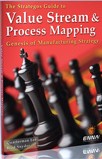|
A Focused Factory strives for a narrow range of products, customers and processes. The result
is a factory that is smaller, simpler and totally focused on one or two
Key Manufacturing Tasks.
The Focused Factory rests on three underlying concepts:
-
There are many ways to compete besides low cost.
-
A factory cannot perform well on every measure.
-
Simplicity & repetition bring competence.
At Strategos, we have seen the effects of focus- customer satisfaction, lower cost and less
frustration. Several researchers have documented these effects with
quantitative studies.
Key Manufacturing Tasks
Skinner's research suggests that a particular factory can excel with no more than one or two
overall objectives. These might be quality, delivery reliability, response time, low cost,
customization, short life cycle products, or another competitive dimension.
The Key Manufacturing Task(s) is the most important thing the factory must do or achieve for
success. Terry Hill, in his book "Manufacturing Strategy" shows how to identify the Key
Manufacturing Task(s) and link it to marketing and corporate strategies.
Why Factories Lose Focus
Some factories are unfocused originally because designers fail to recognize the limits and
constraints of technologies and systems.
Other factories are highly focused at first but lose it over time. Several forces and factors
diffuse the original focus. Among these are:
A Broader View of Focus
In recent years, we have extended Skinner's concept. The strategic question is: "by what
criteria shall we divide our space, people and machines into manageable work units?"
|
 Wickham
Skinner Wickham
Skinner
Wickham Skinner is considered the father of
Manufacturing Strategy. His book "Manufacturing In The Corporate Strategy", published in
1978, set out the principles on which most other work has been based. His seminal
article "The Focused Factory" was published in The Harvard Business Review in 1974 and
is still available from Amazon.com. Dr. Skinner, a graduate of Yale, is an emeritus
professor at Harvard University, where he taught and researched in the field of
industrial management. Dr. Skinner has published three books, co-authored ten case
books, and has written extensively for business magazines and journals.
|
|
 Characteristics of The Focused Factory Characteristics of The Focused Factory
A Focused Factory strives for a narrower range of products, customers or processes. The
result is a factory that is smaller, and has fewer Key Manufacturing Tasks. It optimizes
performance on a few dimensions while sub-optimizing on others.
 Aircraft design offers an analogy. Aerospace engineers can design an aircraft that flies at
Mach 3.0. They can design an aircraft that carries 350 people. They can design an aircraft
that circles the globe on a few hundred gallons of fuel. They can design an aircraft that lands
on a 500 foot runway. They cannot design an aircraft that does all of the above because the
available technology has limits. So it is with factories. Aircraft design offers an analogy. Aerospace engineers can design an aircraft that flies at
Mach 3.0. They can design an aircraft that carries 350 people. They can design an aircraft
that circles the globe on a few hundred gallons of fuel. They can design an aircraft that lands
on a 500 foot runway. They cannot design an aircraft that does all of the above because the
available technology has limits. So it is with factories.
Wickham Skinner, in his seminal 1974 article for The Harvard Business Review, says it
best:
|
 
"The
focused factory will out-produce, undersell, and quickly gain competitive edge over the
complex factory, The focused factory does a better job because repetition and
concentration in one area allows its work force and managers to become effective and
experienced in the task required for success. The focused factory is manageable and
controllable. Its problems are demanding, but limited in scope."
 
|
(The following is from
Professor Skinner's Article)
Process Technologies
Typically, unproven and uncertain technologies are limited to one per factory. Proven, mature
technologies are limited to what their managers can easily handle, typically two or three.
(e.g.,a foundry, metal working and metal finishing.)
Market Demands
These consist of a set of demands including quality, price, lead times, and reliability
specifications. A given plant can usually only do a superb job on one or two demands at any
given period of time.
Product Volumes
Generally these are of comparable levels, such that tooling, order quantities, materials
handling techniques, and job contents can be approached with a consistent philosophy. But what
about the inevitable short runs, customer specials, and one-of-a-kind orders that every factory
must handle? The answer usually is to segregate them.
Quality Levels
These employ a common attitude and set of approaches so as to neither over-specify or over
control quality and specifications. One frame of mind and set of mental assumptions suffice for
equipment, tooling, inspection, training , supervision, job content, and materials handling.
Manufacturing Tasks
These are limited to only one (or two at the most) at any given time. The task at which the
plant must excel in order to be competitive focuses on one set of internally consistent, doable,
non-compromised criteria for success.

|





